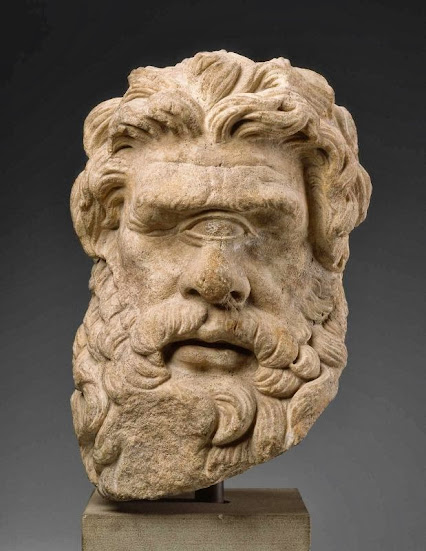
Painting by Johann Heinrich WIlchelm Tischbein, 1802
Kiklopi
su, izgleda, bili strukovno udruženje helenskih kovača bronze. Kiklopi
znači »prstenooki«, jer su, izgleda, imali prstenast znak tetoviran na
čelu u čast sunca, izvora vatre za topionice; Tračani se tetoviraju sve
do u klasična vremena (vidi 28, 2). Koncentrični krugovi su deo
misterije kovačkog zanata; da bi iskovao posude, štitove ili obredne
maske, kovač je upisivao krug oko centra na pljosnatom disku na kome je
radio. Kiklopi su nazvani jednookima i zbog toga što su kovači zatvarali
jedno oko da bi ga zaštitili od varnica. Kasnije im se poreklo
zaboravilo, a mitografi su ih u mašti smestili u grotlo Etne, da bi
objasnili odakle potiču dim i vatra koji, kuljaju iz kratera (vidi 35,
1). Postojala je bliska kulturna veza između Trakije, Krete i Likije.
Kiklopi su biili poznati u svim ovim zemljama. Rana helenska kultura
dopirala je i do Sicilije; ali, kako je Samuel Batler prvi pretpostavio,
vrlo je verovatno da Odisejev boravak na Siciliji objašnjava i tamošnje
prisustvo Kiklopa (vidi 170, b). Imena Bront (''grom''), Sterop
(''munja'') i Argej (''sjaj'') su kasnije izmišljena. Robert Graves, Grčki mitovi

Roman sculpture from the mid-empire (c 200 CE)
The Cyclopes seem to have been a guild of Early Helladic bronze—smiths. Cyclops means 'ring—eyed', and they are likely to have been tattooed with concentric rings on the forehead, in honour of the sun, the source of their furnace fires; the Thracians continued totattoo themselves until Classical times. Concentric circles are part of the mystery of smith—craft: in order to beat out bowls, helmets, or ritual masks, the smith would guide himself with such circles, described by compass around the centre of the flat disk on which he was working.The Cyclopes were one—eyed also in the sense that smiths often shade one eye with a patch against flying sparks. Later, their identity was forgotten and the mythographers fancifully placed their ghosts in the caverns of Aetna, to explain the fire and smoke issuing from its crater. A close cultural connexion existed between Thrace, Crete, and Lycia; the Cyclopes will have been at home in all these countries. Early Helladic culture also spread to Sicily; but it may well be (as Samuel Butler first suggested) that the Sicilian composition of the Odyssey explains the Cyclopes' presence there. The names Brontes, Steropes, and Arges ('thunder','lightning', and 'brightness') are late inventions. Robert Graves, The Greek Myths
The Cyclopes seem to have been a guild of Early Helladic bronze—smiths. Cyclops means 'ring—eyed', and they are likely to have been tattooed with concentric rings on the forehead, in honour of the sun, the source of their furnace fires; the Thracians continued totattoo themselves until Classical times. Concentric circles are part of the mystery of smith—craft: in order to beat out bowls, helmets, or ritual masks, the smith would guide himself with such circles, described by compass around the centre of the flat disk on which he was working.The Cyclopes were one—eyed also in the sense that smiths often shade one eye with a patch against flying sparks. Later, their identity was forgotten and the mythographers fancifully placed their ghosts in the caverns of Aetna, to explain the fire and smoke issuing from its crater. A close cultural connexion existed between Thrace, Crete, and Lycia; the Cyclopes will have been at home in all these countries. Early Helladic culture also spread to Sicily; but it may well be (as Samuel Butler first suggested) that the Sicilian composition of the Odyssey explains the Cyclopes' presence there. The names Brontes, Steropes, and Arges ('thunder','lightning', and 'brightness') are late inventions. Robert Graves, The Greek Myths

Head of Polyphemos, 2nd century AD